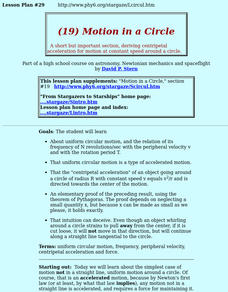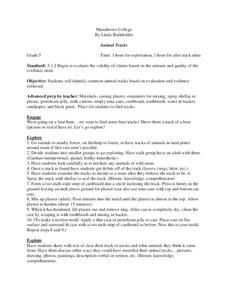Curated OER
MOTION IN A CIRCLE
High schoolers explore uniform circular motion, and the relation of its frequency of N revolutions/sec with the peripheral velocity v and with the rotation period T, and the "centripetal acceleration" of an object.
Curated OER
Why do Stars Rise in the East?
In this stars rise in the east instructional activity, students use geometry to show how the Earth rotates from west to east and why celestial bodies appear to rise in the east and set in the west. Students draw a figure and label given...
Curated OER
Investigation: Reasoning and Proof
Students explore animal characteristics by creating illustrations. In this animal identification lesson, students read a list of animal descriptions which they draw using crayons or colored pencils. Students view their drawings and...
Curated OER
Motion in a Circle
Students study about deriving centripetal acceleration for motion at constant speed around a circle.
Curated OER
Motion in a Circle
Students explore uniform circular motion, and the relation of its frequency of N revolutions/sec with the peripheral velocity v and with the rotation period T. They examine how uniform circular motion is a type of accelerated motion.
Curated OER
Animal Tracks
Sixth graders practice using logic and scientific proof while examining animal tracks. In this scientific method instructional activity, 6th graders identify different animals and the type of tracks they leave behind by observing...
Curated OER
Physical vs. Chemical
In this physical vs. chemical change instructional activity, students answer 10 questions about identifying chemical and physical changes. They identify exothermic and endothermic reactions and the parts of a chemical equation. Students...
Other popular searches
- Geometry Circle Proofs
- Circle Proofs Line
- Circle Proofs in Geometry
- Circle Proofs Length
- Circle Proofs Congruence






